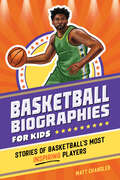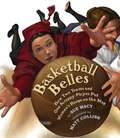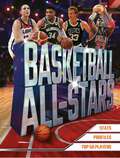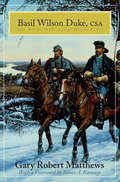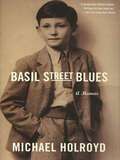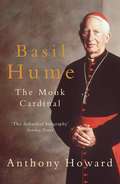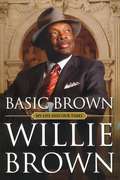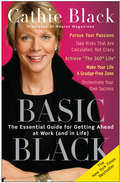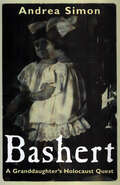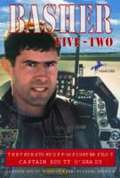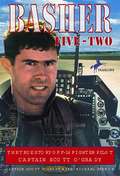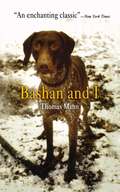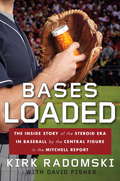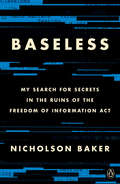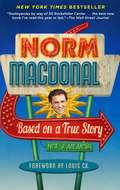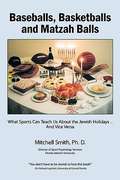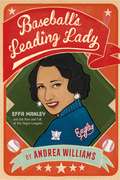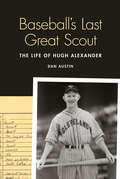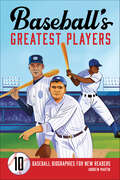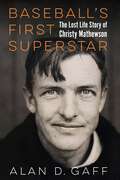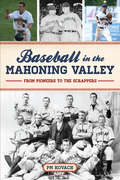- Table View
- List View
Basketball Biographies for Kids: Stories of Basketball's Most Inspiring Players (Sports Biographies for Kids)
by Matt ChandlerGet to know the game with inspiring basketball player biographies for ages 8 to 12Basketball is filled with inspiring stories of world-class athletes working hard and overcoming challenges to shine on the court. Discover the most talented players from each position with Basketball Biographies for Kids! This lineup shows you what it takes to be a WNBA or NBA superstar with the amazing stories, stats, and achievements of the best players from the last 60 years.Legends of the leagues — Learn about the players who changed the game, like Lebron James, Kawhi Leonard, and Sue Bird.Key career stats — Each biography covers the player's history, as well as important info like games played, points, rebounds, assists, and blocks.Draft your own all-star team — Evaluate the statistics and create your fantasy team by filling out the blank sheet at the back of the book.Brush up on your basketball knowledge with the ultimate, slam-dunk collection of sports biographies!
Basketball Belles: How Two Teams And One Scrappy Player Put Women's Hoops On The Map
by Sue Macy Matt Collins Collins MattBasketball All-stars
by David ClaytonSince the founding of the USAs National Basketball League (NBA) in 1946, it has produced many of the coolest, most athletic and best-paid sports stars ever. And, in 1996, the women's game took off, equally producing incredible players who have been hugely inspiring and taking the game to greater heights. Here, we profile 50 of the greatest ever to step foot inside the basketball court and create sporting magic with their power, speed, athleticism, and pure slam-dunking artistry. From Wilt Chamberlain to Steph Curry and Lisa Leslie to Diana Taurasi, you'll get an ultra-cool snapshot of the VIPs of the game, spanning the entire history of these two epic leagues. With complete set of career stats at your fingertips, you'll see why these stars stand out head and shoulders above the rest.
Basil Wilson Duke, CSA: The Right Man in the Right Place
by Gary Robert MatthewsThe first biography of &“one of Kentucky&’s best Confederates . . . [who] became a good citizen working for reconciliation between North and South.&”—The Post and Courier After practicing law for several years in St. Louis, Basil Wilson Duke (1838-1916) enlisted in the Confederate army in 1861 and was elected first lieutenant of John Hunt Morgan&’s legendary cavalry unit. As second in command, he was, Morgan recorded, &“wise in counsel, gallant in the field,&” and always &“the right man in the right place.&” Duke was twice wounded in battle and was captured during Morgan&’s Great Raid and held prisoner for over a year. When Morgan, who was also Duke&’s brother-in-law, was killed in 1864, Duke was promoted to brigadier general and appointed commander of Morgan&’s men. Moving to join forces with those of Gen. Joseph E. Johnston&’s army in North Carolina, he was assigned to the force escorting Jefferson Davis in his retreat from Richmond at the close of the war. Basil Wilson Duke, CSA, the definitive biography of this important but often overlooked figure in Civil War history, establishes that Duke was in fact the brilliant tactician behind much of the success of Morgan&’s cavalry. Author Gary Robert Matthews not only offers an in-depth study of Duke&’s celebrated Civil War exploits but also traces his varied postwar literary, legal, and political careers. &“Fascinating . . . a vividly written story about a modest Southern gentleman in which the reader may come to his own conclusion that Basil W. Duke was the power behind Morgan&’s so-called military genius.&”—Edison H. Thomas, author of John Hunt Morgan and His Raiders
Basil Street Blues: A Memoir
by Michael Holroyd"A wonderful offbeat memoir.... Holroyd has written perhaps his best book yet."—Ben Macintyre, New York Times Book Review Renowned biographer Michael Holroyd had always assumed that his own family was perfectly English, or at least perfectly ordinary. But an investigation into the Holroyd past—guided by old photograph albums, crumbling documents, and his parents' wildly divergent accounts of their lives—gradually yields clues to a constellation of startling events and eccentric characters: a slow decline from English nobility on one side, a dramatic Scandinavian ancestry on the other. Fires, suicides, bankruptcies, divorces, unconsummated longings, and the rumor of an Indian tea fortune permeate this wry, candid memoir, "part multiple biography, part autobiography, but principally an oblique investigation of the biographer's art" (New York Times Book Review). "[A] perfect example of a memoir that entrances me."—Katherine A. Powers, Boston Sunday Globe "[O]ne of the few [biographers] who can convey what makes ordinary as well as extraordinary mortals live in our minds."—Los Angeles Times
Basil Hume: The Monk Cardinal
by Anthony HowardFollowing Cardinal Basil Hume's death on 17 June 1999, The Times concluded his obituary with a remarkable accolade: 'Few churchman in this century, inside or outside the Catholic Church, have died more deeply loved.' Basil Hume served as Cardinal Archbishop of Westminster for twenty-three years and his holiness and wisdom made him an extraordinary leader. In this enthralling biography, Anthony Howard, who has had unique access to Cardinal Hume's private papers and the people who knew him best, traces his life, from his Newcastle upbringing through to his schooling at Ampleforth and his reign at Westminster, including his long and ultimately successful fight on behalf of the Maguire Seven and the Guildford Four.
Basil Hume: The Monk Cardinal
by Anthony HowardFollowing Cardinal Basil Hume's death on 17 June 1999, The Times concluded his obituary with a remarkable accolade: 'Few churchman in this century, inside or outside the Catholic Church, have died more deeply loved.' Basil Hume served as Cardinal Archbishop of Westminster for twenty-three years and his holiness and wisdom made him an extraordinary leader. In this enthralling biography, Anthony Howard, who has had unique access to Cardinal Hume's private papers and the people who knew him best, traces his life, from his Newcastle upbringing through to his schooling at Ampleforth and his reign at Westminster, including his long and ultimately successful fight on behalf of the Maguire Seven and the Guildford Four.
Basic Brown
by Willie L. Brown JrTo The Washington Post, he's "The Last Political Showman of the 20th Century." Bill Clinton has called him "the real Slick Willie." Ronald Reagan's secretary of state George Shultz called this famously liberal politician "a man of his word" and endorsed his successful candidacy for mayor of San Francisco. Indeed Ronald Reagan and Bill Clinton both called upon him for advice and help. He is Willie L. Brown, Jr., and he knows how to get things done in politics, how to work both sides of the aisle to get results. Compared to him, Machiavelli looks meek. And drab. In Basic Brown, this product of rural, segregated Texas and the urban black neighborhoods of San Francisco tells how he rose through the civil rights movement to become the most potent black politician in America through his shrewd understanding and use of political power and political money. He adapts the lessons he has learned so they can be used by anyone -- black, female, male -- intent on acquiring political power. And this master of the political deal demonstrates why deals are not enough, and that political power grows only when public good is being done. Willie Brown shows how some of the most far-reaching and socially advanced legislation in American history -- like gun control, legalized abortion, gay rights, and school funding -- was carried out under his guidance and on his watch, and tells of the ingenuity, the political machinations, and the personal perseverance that were required to enact what now seems to many to be obvious legislation. These are stories of breathtaking, sometimes hilarious ruses and gambits that show that even the most high-minded legislation needs the assistance of the skills of a shark, which is what Willie Brown often sees himself as. Basic Brown is a compendium of insights and stories on the real forces governing power in American political life that will leave you looking at politics anew. It is also the inspiring and funny story of the rise of a gawky teenager in mail-order shoes and trousers who rose to entertain royalty and schoolchildren, superstars and supersize egos, the saintly and the scholarly, while working to transform and open American politics. If you ever wanted to learn how to be slick, a shark, a do-gooder, and a man of your word, Willie L. Brown, Jr., is the storyteller for you.
Basic Black
by Cathie BlackCathie Black is the wise, funny mentor that every woman dreams of having. She was a pioneer in advertising sales at a time when women didn't sell; served as president and publisher of the fledgling USA Today; and, in her current position as the president of Hearst Magazines, persuaded Oprah to launch a magazine. In 2006 she was named one of Fortune's "50 Most Powerful Women in American Business" for the seventh consecutive year. Now, in the exuberant, down-to-earth voice that is her trademark, Cathie explains how she achieved "the 360° life"--a blend of professional accomplishment and personal contentment--and how any woman can seize opportunity in the workplace. No matter where you are in your career, Basic Black offers invaluable lessons that will help you land the job, promotion, or project you're vying for. At the core of the book are Cathie's candid, personal stories. She walks us through her decision to risk dropping a huge ad agency that handled the USA Today campaign in favor of a small boutique agency run by a wild man. (It was a smash.) She admits that her sometimes brusque style once led to a mutiny of staffers at Ms. (She learned to be more flexible in her managerial style.) She offers a clear-eyed look at what happened during the twenty-eight months between the launch and the close of the much-buzzed-about Talk magazine. And throughout, she offers fascinating glimpses of media and business personalities, such as Rupert Murdoch, Tina Brown, Frank Bennack, Vic Ganzi, former Cosmo Girl! editor Atoosa Rubenstein, Bonnie Fuller, and the legendarily difficult Al Neuharth, founder of USA Today. Above all,Basic Black is motivating. It provides a close-up look at the keen judgment, perseverance, and optimism that have propelled Cathie Black to the top of her game, along with the kind of straight-up practical advice you get in a one-on-one session with a career coach. You'll find out how to handle job interviews, which rules to break, and why you should make your life a grudge-free zone. Equally important, you'll be inspired to pursue your passions and achieve your very best.
Bashert: A Granddaughter's Holocaust Quest (Willie Morris Books in Memoir and Biography)
by Andrea SimonHaunted by her grandmother's Old World stories and bigger-than-life persona, Andrea Simon undertook a spiritual search for her lost family. Her sojourn, a quest for truth, gave her tragic answers. On a group tour of ancestral Jewish homeland sites that had been crushed in the Holocaust, she makes a riveting detour to her grandmother's village of Volchin, in what is now Belarus, where the last known family members had lived. There, she followed the trail of the death march taken by the village Jews to the place of their slaughter by Nazis and Nazi collaborators in the fall of 1942. During the same period, in Brona Gora, a forest between Brest and Minsk, some 50,000 Jews were shot. Simon was in one of the first American groups to visit this little-publicized site. Bashert, the Yiddish word for fate, guided her through the arduous quest. With newly translated archival records, she peeled back layers of clues to confront the mystery. This story of her momentous odyssey reveals the terrible fate of her kin. Mass shootings of Jews, particularly in the Soviet Union, have not been addressed with the same focus given to concentration-camp atrocities. Yet Simon's research reveals that Nazis killed nearly fifty percent of their Jewish victims by means other than gassing. In the historiography of the era, comparatively scant reference is made to the executions at Brona Gora. Thus Simon fills a significant gap in Holocaust history by providing the most extensive report yet given on the executions at Brona Gora and Volchin. As she interweaves tragic narrative with evocative family anecdotes, Simon writes a story of life in czarist Russia and, within this frame, of her family's flight from pogroms and persecution. From a unique vantage Simon's memoir discloses her dogged genealogical search, the newly perceived Jewish history she uncovered, and the ramifications of the Holocaust in the postwar generation.
Basher Five-Two: The True Story of F-16 Fighter Pilot Captain Scott O'Grady
by Scott O'Grady Michael FrenchWhile flying his F-16 in Bosnia, O'Grady was shot down. His plane exploded and he parachuted down into enemy territory. This is how he evaded capture with little water and no food.
Basher Five-Two
by Scott O'GradyU.S. Air Force pilot Captain Scott O'Grady was shot down in his F-16 over Bosnia while helping to keep the peace. The plane exploded, and Captain O'Grady fell 5 miles to the ground below. In exciting detail, Captain O'Grady tells how he evaded capture and how, with little water and no food, he was able to survive on his own in enemy territory. This is a thrilling look at an American hero--a hero not because the captain survived, but because of the skill, faith, and courage he displayed and the duty he fulfilled as a member of the armed forces.From the Hardcover edition.
Bashan and I
by Thomas Mann Herman George ScheffauerBashan and I is the moving story of Thomas Mann's relationship with his spirited German short-haired pointer. From their first encounter at a local farm, Mann reveals how he slowly grows to love this energetic, loyal, and intelligent animal. Taking daily walks in the nearby parkland, Mann begins to understand and appreciate Bashan as a living being, witnessing his native delight in chasing rabbits, deer, and squirrels along with his careful investigations of stones, fallen branches, and clumps of wet leaves. As their bond deepens, Mann is led to contemplate Bashan's inner life, and marvels at the ease with which his dog trusts him, completely putting his life into his master's hands.Over time, the two develop a deep mutual understanding, but for Mann, there is always a sense of loss at never being able to enter the private world of his dear friend, and he slowly becomes conscious of the eternal divide between mankind and the rest of nature. Nonetheless, the unique relationship quietly moves to the forefront of Mann's life, and when master and companion are briefly separated, Mann is taken aback by the depth of his loneliness without his dog. It is this deep affection for another living creature that helps the writer to reach a newfound understanding of the nature of love, in all its complexity.First published in 1916 and translated into English in 1923, Bashan and I was heralded for its simple telling of how a dog became a priceless companion, an animal who brought meaning to the author's life.
Bases Loaded
by Kirk RadomskiGame of Shadows meets Ball Four in this explosive inside account of baseball's steroid era On a quiet street on Long Island early on a December morning in 2005, more than fifty federal agents stood outside a lovely new home waiting for the front door to be opened. When it did, there stood the central figure in one of the biggest scandals in sports history: Kirk Radomski. Radomski was a regular New York kid who, from the age of fifteen had the amazing fortune of working in the Mets clubhouse. The focus of his job was to give the players whatever they wanted or needed-he got their uniforms ready, packed up their homes at the end of the season, cashed their checks, and helped them beat the drug tests that would have led to suspension. And at the end of the 1986 season he even led the World Champions down Broadway during their victory parade. Eventually, he graduated to helping in other ways: providing them with steroids and human growth hormones. By the time the Feds knocked on his door, he was the main clubhouse supplier of performance-enhancing drugs to almost three hundred baseball players. Under threat of a long prison sentence-and after being identified by players he'd helped-he cooperated with Senator George Mitchell to produce the Mitchell Report, providing names and dates. Now he's ready to tell the whole story to the world. Radomski made little money from these transactions, and in this stunning book he will recount what baseball knew about the problem, his life since the report came out, and who took what. This is the tale of a young man seeing his heroes turn into clay, and the degradation of a once great sport into the drug-addicted spectacle it has become.
Baseless: My Search for Secrets in the Ruins of the Freedom of Information Act
by Nicholson BakerA major new work, a hybrid of history, journalism, and memoir, about the modern Freedom of Information Act – FOIA – and the horrifying, decades-old government misdeeds that it is unable to demystify, from one of America's most celebrated writers <P><P>Eight years ago, while investigating the possibility that the United States had used biological weapons in the Korean War, Nicholson Baker requested a series of Air Force documents from the early 1950s under the provisions of the Freedom of Information Act. Years went by, and he got no response. <P><P>Rather than wait forever, Baker set out to keep a personal journal of what it feels like to try to write about major historical events in a world of pervasive redactions, witheld records, and glacially slow governmental responses. The result is one of the most original and daring works of nonfiction in recent memory, a singular and mesmerizing narrative that tunnels into the history of some of the darkest and most shameful plans and projects of the CIA, the Air Force, and the presidencies of Harry Truman and Dwight Eisenhower. <P><P>In his lucid and unassuming style, Baker assembles what he learns, piece by piece, about Project Baseless, a crash Pentagon program begun in the early fifties that aimed to achieve "an Air Force-wide combat capability in biological and chemical warfare at the earliest possible date." <P><P>Along the way, he unearths stories of balloons carrying crop disease, leaflet bombs filled with feathers, suicidal scientists, leaky centrifuges, paranoid political-warfare tacticians, insane experiments on animals and humans, weaponized ticks, ferocious propaganda battles with China, and cover and deception plans meant to trick the Kremlin into ramping up its germ-warfare program. <P><P>At the same time, Baker tells the stories of the heroic journalists and lawyers who have devoted their energies to wresting documentary evidence from goverment repositories, and he shares anecdotes from his daily life in Maine feeding his dogs and watching the morning light gather on the horizon. The result is an astonishing and utterly disarming story about waiting, bureaucracy, the horrors of war, and, above all, the cruel secrets that the United States government seems determined to keep forever from its citizens.
Based on a True Story: A Memoir
by Norm Macdonald<P>Wild, dangerous, and flat-out unbelievable, here is the incredible memoir of the actor, gambler, raconteur, SNL veteran, and one of the best stand-up comedians of all time. <P>As this book's title suggests, Norm Macdonald tells the story of his life--more or less--from his origins on a farm in the-back-of-beyond Canada and an epically disastrous appearance on Star Search to his account of auditioning for Lorne Michaels and his memorable run as the anchor of Weekend Update on Saturday Night Live--until he was fired because a corporate executive didn't think he was funny. But Based on a True Story is much more than a memoir; it's the hilarious, inspired epic of Norm's life. <P>In dispatches from a road trip to Las Vegas (part of a plan hatched to regain the fortune he'd lost to sports betting and other vices) with his sidekick and enabler, Adam Eget, Norm recounts the milestone moments, the regrets, the love affairs, the times fortune smiled on his life, and the times it refused to smile. As the clock ticks down, Norm's debt reaches record heights, and he must find a way to evade the hefty price that's been placed on his head by one of the most dangerous loan sharks in the country. <P>As a comedy legend should, Norm peppers these pages with classic jokes and fondly mythologized Hollywood stories. This wildly adventurous, totally original, and absurdly funny saga turns the conventional "comic's memoir" on its head and gives the reader an exclusive pass into the mad, glorious mind of Norm Macdonald. <P><b>A New York Times Bestseller</b>
Based on a True Story
by Anthony HoldenFrom poker to poetry, poisoners to princes, opera to the Oscars, Shakespeare to Olivier, Mozart to Murdoch, Anthony Holden seems to have rolled many writers&’ lives into one. Author of 35 books on a &‘crazy&’ range of subjects, this cocky Lancashire lad-turned-bohemian citizen of the world has led an apparently charmed life from Merseyside to Buckingham Palace, the White House and beyond. As he turns 70, the award-winning journalist and biographer – grandson of an England footballer, son of a seaside shopkeeper, friend of the famous from Princess Diana to Peter O'Toole, Mick Jagger to Salman Rushdie – spills the beans on showbiz names to literary sophisticates, rock stars to royals as he looks back whimsically and wittily on a richly varied, anecdote- and action-packed career – concluding, in the words of Robert Louis Stevenson, that &‘Life is not a matter of holding good cards, but of playing a poor hand well&’.
Baseballs, Basketballs and Matzah Balls: What Sports Can Teach Us About the Jewish Holidays... and Vice Versa
by Mitchell SmithBaseballs, Basketballs, and Matzah Balls offers a sweeping exploration of sports - of competitions and heroes, of victory and adversity, of grit and courage, of strategy and execution - and examines how these themes relate to the festivals that Jews have celebrated for thousands of years.
Baseballs Sluggers and Pitchers
by Steve BuckleyChildren's biographies of 14 baseball pitchers and hitters: Sammy Sosa, Greg Maddux, Derek Jeter, Curt Schilling, Barry Bonds, Pedro Martinez, Ken Griffey Jr., Mike Mussina, Mark McGwire, Roger Clemens, Mo Vaughn, Kevin Brown, Mike Piazza, and Randy Johnson.
Baseball's Leading Lady: Effa Manley and the Rise and Fall of the Negro Leagues
by Andrea WilliamsFor fans of Hidden Figures and Steve Sheinkin's Undefeated, Andrea Williams's Baseball's Leading Lady is the powerful true story of Effa Manley, the first and only woman inducted into the National Baseball Hall of Fame.Before Jackie Robinson broke Major League Baseball's color barrier in 1947, Black athletes played in the Negro Leagues--on teams coached by Black managers, cheered on by Black fans, and often run by Black owners. Here is the riveting true story of the woman at the center of the Black baseball world: Effa Manley, co-owner and business manager of the Newark Eagles. Elegant yet gutsy, she cultivated a powerhouse team. Yet just as her Eagles reached their pinnacle, so did calls to integrate baseball, a move that would all but extinguish the Negro Leagues. On and off the field, Effa hated to lose. She had devoted her life to Black empowerment--but in the battle for Black baseball, was the game rigged against her?
Baseball's Last Great Scout: The Life of Hugh Alexander
by Dan AustinLate in 1937 Hugh Alexander, a kid fresh out of small-town Oklahoma, had just finished his second year playing outfield for the Cleveland Indians when an oil rig accident ripped off his left hand. Within three months he was back with the Indians, but this time as a scout—the youngest ever in Major League history. In the next six decades he signed more players who made it to the Majors than any other scout. His story, Baseball’s Last Great Scout, reads like a backroom, bleacher-seat history of twentieth-century baseball—and a primer on what it takes to find a winner. It gives a gritty picture of learning the business on the road, from American Legion field to try-out camp to beer joint, and making the fine distinctions between “performance” and “tools of the trade” when checking out prospects. Over the years Alexander worked for the Indians, the White Sox, the LA Dodgers, the Phillies, and the Cubs—and signed the likes of Allie Reynolds, Don Sutton, and Marty Bystrom. This book, based on extensive interviews and Alexander’s journals, is filled with memorable characters, pithy lessons, snapshots of American life, and a big picture of America’s pastime from one of its great off-the-field players.
Baseball's Greatest Players: 10 Baseball Biographies for New Readers
by Andrew MartinIntroduce kids ages 6 to 9 to a century of baseball's biggest stars From legendary sluggers to civil rights heroes, the game of baseball has seen a lot of amazing players—and this book features 10 of the very best. Perfect for new fans or those who already know a thing or two about baseball, this kid-friendly guide is packed full of fun facts and essential stats that will teach them all about the incredible careers of these sports superstars.What sets this collection of baseball biographies apart:10 decades, 10 players—Starting in the 1920s, this book shows the ways players like Babe Ruth, Jackie Robinson, and Mike Trout have made history.Runners up—Each decade also includes a brief look at some of the other greats, including Bob Gibson, Ken Griffey Jr., and Ichiro Suzuki.A helpful glossary—All of the terms kids need to know are highlighted and defined in the back of the book.Super stats—Kids will see exactly how outstanding each player was with a quick breakdown of their career stats.Delight young fans and get them interested in the history of the game with this standout among baseball books.
Baseball's Great Tragedy: The Story Of Carl Mays, Submarine Pitcher
by Bob McGarigleBiography of Carl Mays, the New York Yankees pitcher who fatally struck Cleveland Indians batter Ray Chapman with a pitch in 1920.
Baseball's First Superstar: The Lost Life Story of Christy Mathewson
by Alan D. GaffIf there was a first face of baseball, it was arguably Christopher &“Christy&” Mathewson. At the opening of the twentieth century, baseball was considered an undignified game played by ruffians for gamblers&’ benefit. Mathewson changed all that. When he signed with the Giants in 1900, his contract stated he wouldn&’t pitch on Sundays, and he was known for his honesty, integrity, and good looks. In his first fourteen seasons, as a pitcher for the Giants, Mathewson never won fewer than twenty games in a season, and he almost single-handedly won the 1905 World Series. In 1918, though age thirty-eight and exempt from military service, he enlisted for World War I, where he exposed himself to nearly lethal amounts of mustard gas as he taught soldiers how to put on gas masks. When he returned home, he was diagnosed with lung problems and tuberculosis, which led to his untimely death at the age of forty-five. After Mathewson&’s death, his eulogies were many, but it was impossible to catch the essence of his life in a single newspaper column. Jane Mathewson, his widow, was determined to provide the reading public with a more intimate portrait of her husband and approached prominent sportswriter Bozeman Bulger, who had known Mathewson for twenty years. Bulger wrote a series of articles titled &“The Life Story of Christy Mathewson.&” His portraits about the player were amplified by original accounts from Jane, and several unpublished chapters from Mathewson himself, which had been discovered among his papers. These combined accounts allow readers to hear from Mathewson and those who knew him best. A superstar long before that term was coined, Mathewson became an icon of sportsmanship. He was posthumously elected to the Baseball Hall of Fame at its first induction ceremony in 1936. In Baseball&’s First Superstar Alan D. Gaff brings Mathewson to life through Mathewson&’s own writings and those of others, largely lost to history until now.
Baseball in the Mahoning Valley: From Pioneers to the Scrappers (Sports)
by Paul M. KovachAround the horn in the Mahoning Valley The history of baseball in Ohio's Mahoning Valley has been, to say the least, eventful. Murder, the Civil War, the hot dog, a presidential assassination and one of the deadliest known volcanic eruptions all shaped America's pastime in the Valley. African American baseball pioneer and Hall of Fame inductee Bud Fowler began his professional baseball career in the area, and the first ceremonial celebrity first pitch came from the arm of a prominent local. The area also contributed to Cleveland professional ballclubs like the enigmatic 1883 Blues and the 2016 Believeland Indians, which included numerous players from the Mahoning Valley Scrappers, a minor-league team with its own rich heritage. Digging up little-known facts about Fowler and sundry other colorful stories, local author and creator of Eastwood Field's Days Gone By exhibit PM Kovach celebrates the proud history of baseball in northeast Ohio.
